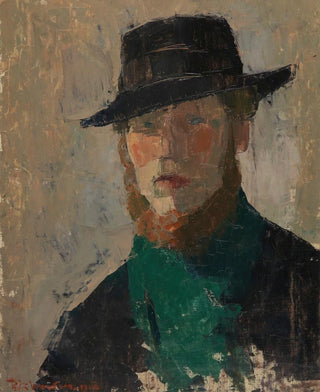Art print | Self-portrait with Black Hat - Rik Wouters


View from behind

Frame (optional)
The Black Hat Self-Portrait by Rik Wouters is a work that transcends mere artistic exercise to become a true mirror of its creator's soul. Painted in 1910, this painting does more than depict a face; it invites the viewer to delve into the intimacy of an artist in search of his own identity. The depth of emotion conveyed, combined with refined pictorial technique, offers a visual and emotional experience that captivates anyone who lingers on it. This masterpiece, both personal and universal, evokes reflections on solitude, creativity, and self-relationship, making it an essential work from the early 20th century.
Style and uniqueness of the work
Wouters' style is distinguished by its expressive and colorful approach, where each brushstroke seems charged with emotional intensity. In the Black Hat Self-Portrait, dark hues blend with flashes of light, creating a play of shadows and highlights that gives a particular dynamism to the painting. The black hat, a symbol of mystery and elegance, immediately draws the eye and embodies the duality of the artist himself: both visible and hidden, accessible and enigmatic. The facial features, though stylized, reveal great expressiveness, bearing witness to Wouters' inner turmoil. This blend of realism and abstraction, typical of his style, creates an almost palpable atmosphere where the viewer can feel the raw emotions emanating from the work.
The artist and his influence
Rik Wouters, an emblematic figure of Belgian painting, is often associated with the expressionist movement, although he developed a pictorial language unique to him. His artistic journey, marked by an incessant quest for truth and authenticity, reflects an era when artists sought to break free from academic conventions. Wouters, influenced by masters such as Vincent van Gogh and Henri Matisse, skillfully integrated elements of these styles while forging a distinctive artistic identity. His ability to capture light

Matte finish

View from behind

Frame (optional)
The Black Hat Self-Portrait by Rik Wouters is a work that transcends mere artistic exercise to become a true mirror of its creator's soul. Painted in 1910, this painting does more than depict a face; it invites the viewer to delve into the intimacy of an artist in search of his own identity. The depth of emotion conveyed, combined with refined pictorial technique, offers a visual and emotional experience that captivates anyone who lingers on it. This masterpiece, both personal and universal, evokes reflections on solitude, creativity, and self-relationship, making it an essential work from the early 20th century.
Style and uniqueness of the work
Wouters' style is distinguished by its expressive and colorful approach, where each brushstroke seems charged with emotional intensity. In the Black Hat Self-Portrait, dark hues blend with flashes of light, creating a play of shadows and highlights that gives a particular dynamism to the painting. The black hat, a symbol of mystery and elegance, immediately draws the eye and embodies the duality of the artist himself: both visible and hidden, accessible and enigmatic. The facial features, though stylized, reveal great expressiveness, bearing witness to Wouters' inner turmoil. This blend of realism and abstraction, typical of his style, creates an almost palpable atmosphere where the viewer can feel the raw emotions emanating from the work.
The artist and his influence
Rik Wouters, an emblematic figure of Belgian painting, is often associated with the expressionist movement, although he developed a pictorial language unique to him. His artistic journey, marked by an incessant quest for truth and authenticity, reflects an era when artists sought to break free from academic conventions. Wouters, influenced by masters such as Vincent van Gogh and Henri Matisse, skillfully integrated elements of these styles while forging a distinctive artistic identity. His ability to capture light






